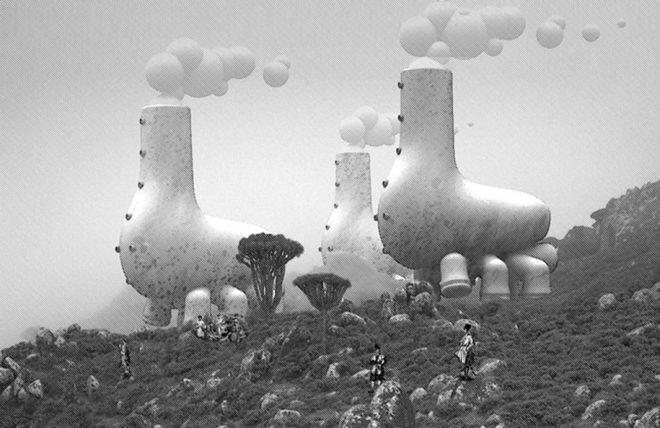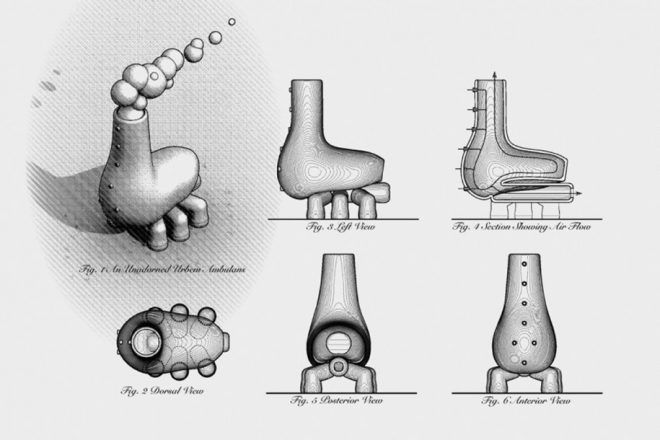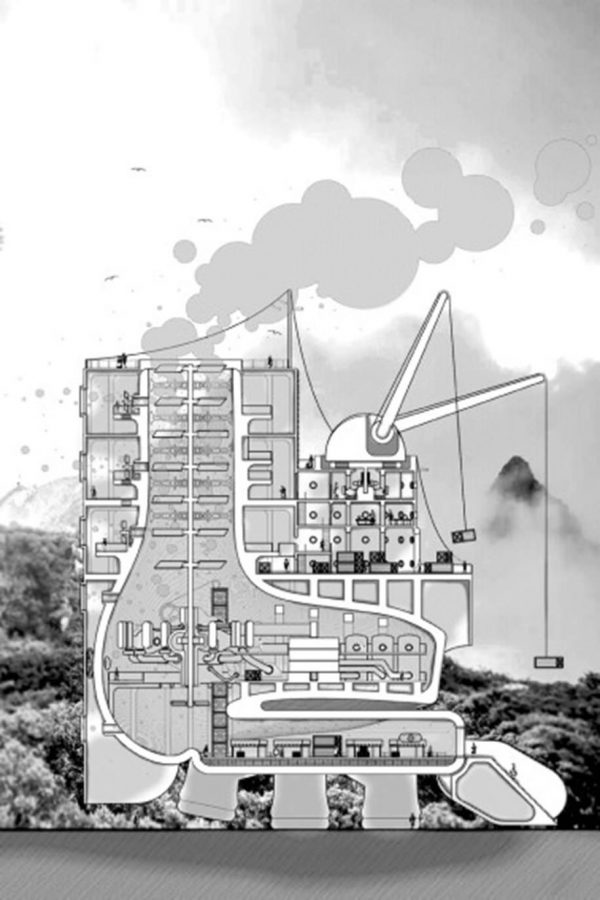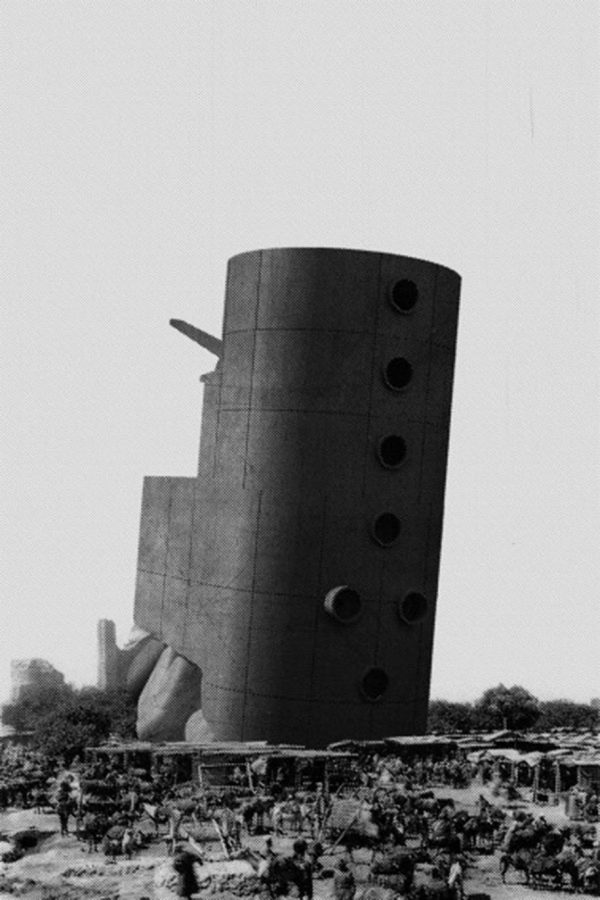City Walkers by Terrence Hector
I struck up a conversation with a foreign traveler, a diplomat from an unspecified country, one of the many vassal states of the Russian Empire, as he remarked on an illustration in Augustus Pugin’s “Contrasts”, which I was then reading. Upon seeing Pugin’s Illustration of a Catholic Town in the 15th century and then altered by industry, he claimed to have knowledge of an ancient city where the opposite change had occurred, not because of the idiosyncrasies of local religious architecture, but because “the Towers of Industry had died.”
Finding his choice of words unbelievable, he assured me the meaning was literal, and I pressed for more information. He claimed to be in possession of a history from the end of this city’s age of natural industry, and would provide me a copy.
He did not reveal his name, and I lost contact with him, my only source of information, after that week. The only lead for future investigation is the similarities between the wording of the document and medieval descriptions of the flora of the island of Socotra, as well as anatomical similarities to the subphylum Tunicata as described by Lamark. These relationships are explored in my illustrations.
The following text is an abridged translation of that document, supported by illustrations depicting the buildings / organisms described.
“Nobody quite remembers when we began to coexist with the Walkers, but everyone remembers when they began to die. The City had always seemed to exist since the beginning of history, its continued prosperity the consequence of a mutualist relationship between two species: the City Walkers and the Human City Dwellers that lived amongst them.
The City Walkers, while they were certainly alive, existed at a tempo so much slower than the human lifespan that they functioned as both landscape and domesticated animal. It is believed that the first human settlers mistook them for geological features or monstrous abandoned termite nests upon their discovery.
They dwarfed even the tallest trees, and as far as the early city-dwellers were concerned, theses creatures might as well have been part of the landscape. They were incomprehensibly slow, taking a step once every lunar cycle. Settlements grew beneath, and then around and behind the paths of individual beings in the herd.

The City Walkers were massive, bowely creatures; 200 foot tall rotund and hollow bio-vessels supported on six stocky legs. Their chitinous skin was covered with thick layers of dirt and dust, giving them the appearance of unfired pottery. Existing representation of the Walkers shows the individuals that made up the herd being uniform in appearance, with only minuscule differences in what could be considered identifying features.
A column of holes, single file except for a pair on the widest part of the “belly”, were evenly space on the anterior surface of the Dorsal Chimney, defining what could be considered the “face”. The “belly” rested on, and drooped over, the secondary Ventral Chimney, to which the legs were attached.

The City Walkers’ digestive system, the discovery of which led to their inevitable exploitation, was a form of passive filter feeding. Airborne bacteria and microscopic animals were sucked in and digested, with air waste exhaled out of the Walker’s Dorsal Chimney. The persistent airflow, made the insides of the Walkers habitable to humans, and would lead to the first Walker-mills. The micro-climates and constant, isolated wind flow was at first used to power small machines. Tiny, parasitic Mills were precariously fixed to the bodies and chimneys of the Walkers at the strip of the dorsal holes, and for larger industries windmill sails were placed inside the Dorsal Chimney.

As the demand for production continued to grow, the scaffolding and cantilevered mills developed into united factories, encasing the Walker they were mounted on (Plates 3 and 4). These traveling Towers of Industry became seats of oligarchical power, surrounded by shifting neighborhoods supporting them. The production from the Towers was enough to supply entire monopolies, with the Walker’s constant wind harnessed for a single purpose.
The City Walker’s lunar step-cycle was the rhythm around which the city grew. Trails of buildings sprouted in their wake, and administrators and royal scientists gained prominence through the institutionalization of predicting Walker movement, tasked with preventing construction under potential footfalls. Transient markets followed in the Walker’s shadow, selling and bartering the goods produced above them. The city slowly followed the herd, living and profiting from their production.

For several hundred years the City Walkers walked and left their trail. The city grew, until the Walkers stopped and fell and died, one by one. It was believed that some previously unknown sense caused the remaining City Walkers to avoid the bodies of their fallen kin. The tempo of the city suddenly accelerated; it was now beginning to live on a Human timescale. For the first time, there was a space in the city that could be built up without any chance of traditional Walker intervention. These “Graveyards” surrounding the monumental corpses became flourishing permanent settlements and the first instances of solely Human architecture.
The remains of the City Walkers and their factory shells were repurposed as markets, temples and other civic institutions. The fabric of city, expanding to replace the lost industry, filled in the space between them. The former icons of the city became massive public monuments, dead forms instead of living creatures shaping a living city.
The Herd, the Towers of Industry, the Walkers have died, and a new, dead city has formed in their place.”
Text by the architect.
About the competition
Since its inception in 2013, the annual Fairy Tales challenge has attracted thousands of participants. Winners have gone on to develop their stories into successful campaigns, short films, comic books, and exhibitions.
This years winners were chosen by a jury of more than 20 leading architects, designers and storytellers. The jury ncluding Marion Weiss, Michel Rojkind, Jing Liu, Dan Wood and John Maeda, among many other distinguished judges. Chase W. Rynd, the Executive Director of the National Building Museum.
“The proposals put forth in the Fairy Tales competition create entire worlds of the imagination. They build their immersive stories as much by what they don’t say, as by what they do. The winning entries in this year’s competition include oblique references to current events, mundane daily activities and relatable human emotions. They make visible how we shape space, and in turn, how space shapes us. The images and narratives are so wildly outlandish, and yet, so grounded that it seems like we could mistakenly stumble into any of them. They are personal and powerful – a testament to the power of architecture as a world-builder.”
See all the winners of the 4th Annual Fairy Tales Competition here.
READ ALSO: Yoann Cimier Captures the Vivid Life of Tunisia's Seaside